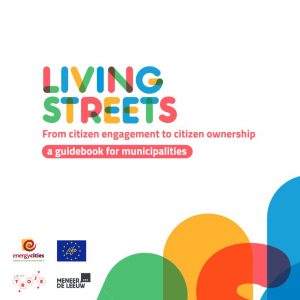In Brussels (1,175,000 inhabitants), the Living Streets target the improvement of the quality of life in the public space by meeting and reflecting on the problems of the streets among the inhabitants and Brussels Participation. In this framework the inhabitants are seen as the experts of their streets. The focus is not only on closing the street to cars but also on coming together and reflecting on the needs of the streets and then co-creating the street and finding creative solutions to the daily problems. To date, Living Streets have been tested in Brussels in several neighbourhoods and streets with different typologies. The initiative is called “Rue à vivre” or “Leefstraat” (Streets to live).
How are Living Streets organised in Brussels ?
Each Living Street requires a preparation period of about three months and thereafter is publicly implemented during one to two months. Living Streets can be organised at any time of the year. An application needs to be submitted by the initiators and the city of Brussels and the Police department need to give the green light for it. A project can be allocated a budget between 1,000 and 5,000 euros.
Brussels Participation is the service of the City of Brussels that supports project leaders launch a Living Street. There is close collaboration with various municipal departments : Participation, Green Spaces and Environment.
The main requirements to organise a Living Street :
- Any inhabitant of the City of Brussels can launch a Living Street where s/he resides.
- The initiator can be an individual, an association, a neighbourhood committee or residents’ collective.
- The initiator needs to mobilise at least three inhabitants of the street and create a leading group.
“You live in your street, you know it better than anyone else. To know how you want to live in your street, we need your help. The existing situation can always improve and we think that you can play a key role here.” (Els Ampe, Deputy Mayor in charge of public works, mobility and vehicle fleet, City of Brussels)

Sint Jan Nepomucenus Street, Living Streets © Municipality of Brussels
The creation and implementation phases of a Living Street :
- Define the project : choose the location (one or several streets, a market, a public square). At this moment, the steering groups meet Brussels Participation and other municipal services to get feedback on their first ideas and actions they want to implement. To smoothen this step, the municipality prepared a Vade Mecum, a manual helping project leaders to frame their project, working method and budget.
- Field work done by inhabitants : they engage with the other inhabitants via surveys and meetings to choose the actions and to create the steering group, composed of a minimum of three residents.
- Submit the application : there is a form that the steering group needs to fill in and submit to Brussels Participation that details the needs of the street, the vision for their street as well as precise actions and timeframe with a budget. They submit their request for authorisations to be able to close the streets to cars and to organise events in the public space. Via this ’Declaration claim’ form, project leaders agree to respect the Vade Mecum.
- The City of Brussels can advance 80% of the amount requested to the project leader. The remaining 20% will be paid after the presentation of the final report and all financial evidence and after approval by the Council.
- Launch of public activities during the agreed period.
- Submit a final report and all financial evidence.
The municipality of Brussels communicates and promotes the Living Streets via information sessions to citizens in order to raise awareness and encourage the organisation of Living Streets. The initiative has been implemented in 8 streets so far.
In Brussels, the Living Streets tackled many aspects such as prostitution, need for positive animation of public spaces and ownership by their inhabitants, need for green spaces, need for silence in an area impacted by public works during several years, reflecting on the need for a residential zone for meeting and sharing among inhabitants.
What are the lessons learned ?
- Everyone wants to join the party, but no one wants to organise it ! It is difficult to move from interest in a project to concrete action as many people are enthusiastic but not necessarily ready to take action to implement and steer the project.
- Involving the press and media too early in the process puts pressure on people
- There was no vandalism during the project, all equipment was respected by the neighbours and other users. However, after the project ended, some equipment was taken over by homeless people.
- A Living Street takes long to organise, it is multifaceted and not immediately visible, making it complex to handle.
- Strong social ties were developed among the neighbours and the resistance of some inhabitants has been overcome by allowing them to concretely visualise the city of the future.
- Residents’ ownership of their street increased via DIY equipment that helped embellish the public space, make it more pleasant and adapted to citizens’ needs and expectations.
For the future of the initiative in Brussels, it was concluded that a Living Streets needs to be extended over longer periods of time in order to meet the expectations of the residents and put them in practice. It is also important to organise several Living Streets in the same spot, to experiment and possibly implement certain solutions on a permanent basis.


